How to Create a Multiaxis Cuts Along Curve Feature
Introduction
This tutorial explains how to create a Cuts Along Curve feature. This feature requires the selection of a Lead Curve, which is used to create the toolpath. The toolpath slices are created at a right angle to Lead Curve. This toolpath is applied to the second required selection, the Drive Surface. The Lead Curve can be on the surface, a surface edge, or you can assign wireframe geometry as shown in this tutorial. If the Lead Curve creates intersecting toolpath segments, then the calculation will fail, and the curve must be recreated.
Example File
If you are connected to the Internet, the part file for this example can be downloaded automatically by clicking the following link: Cuts Along CurveExample 1.sldprt
Once you download and saved the zip file, extract the files on your system in an easy place to remember.You can then open the file to use with this tutorial. All files for the tutorials in this help system available for download can be found by clicking on the following link: http://www.bobcad.com/helpfiles.
In the example file provided, the stock and Machine Setup are already defined for the part. The part is simulated using the BC Table Table machine.
In this example, you create a toolpath that can be used to rough or finish the outside of a cylinder. Instead of using a solid model, a surface (zero thickness) is used to show how the surface normal direction can be changed to cut the opposite side of the surface. This action is then applied to this example to create a finishing toolpath for the inside of the cylinder.
Part 1) Add the Feature
-
In the Property Manager, click the
 CAM Tree tab.
CAM Tree tab. -
Right-click
 Machine Setup and click Mill Multiaxis.
Machine Setup and click Mill Multiaxis. -
In the Multiaxis Wizard, click Surfaceand select Cuts Along Curve.
-
Click Next>>to go to the Posting dialog box.
Part 2) Define the Posting Parameters
-
The Work Offset # is automatically set to the value defined in the Machine Setup dialog box.
You can change the value here to update the Work Offset # for the feature. -
Click Next>>to go to the Multiaxis Postingdialog box.
Part 3) Define the Multiaxis Posting Parameters
-
Notice, at the top of the dialog box, that the Use Machine Settings checkbox is selected.
This means that the Multiaxis Posting parameters for the feature use the same parameters as the machine that is selected in Current Settings.
You can clear the Use Machine Settingscheck box to define the Multiaxis Posting parameters of the feature separately from the current machine settings.
An example usage is explained later. -
Click Next>>to go to the Tool page.
Part 4) Define the Tool Parameters
-
In the Tool Data group, clear the
 System Tool check box.
System Tool check box.
Set the Diameter to 0.50and the Flute Length to 3.00.
Set the Corner Radius to 0.25 and the Overall Length to 5.00. -
Click Assign Tool Holder.
In the Milling Tool Holder Library CAT 40 Holder list, click 0.5 inch I.D. Arbor CAT 40.
At the bottom of the dialog box, click OK.
(If you assign a tool holder to a tool in the Tool Library, that holder is automatically assigned and Step 2 can be eliminated.) -
Click Next>>to go to the Parameters dialog box.
Part 5) Select Geometry
-
To define the lead curve, in the Surface Paths tab under Pattern, click Lead.
-
In the graphics area, select the Lead Curve.
The toolpath for the feature is created normal (at a right angle) to the curve.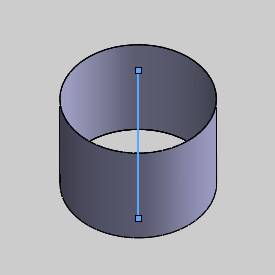
-
To confirm the selection, click
 (OK).
(OK). -
Click Drive Surfaces, and in the graphics area, select the geometry to which the toolpath is applied.
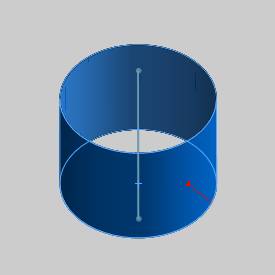
-
To confirm the selection, click
 (OK).
(OK).
The geometry selection is complete.
Part 6) Define the Parameters and Compute the Toolpath
-
To leave stock material for a finish operation, in the Pattern group, in the Drive Surface Offset box, type 0.030.
-
In the Areagroup, next to Type, select Full, Start and End at Exact Curve End Points.
Notice by the name, that this parameter is in reference to the Lead Curve, and not the Drive Surface as is the case for the other surface features. Any part of the Lead Curve that can't be projected onto the surface, is not used. So, for this example, this causes the first toolpath slice to start at the exact surface edge, or rather the exact curve end points. -
In the Sortinggroup, next to Cutting Method,select Spiral.
-
In the Stepovergroup, set the Maximum Stepover to 0.250 (A large stepover is used to better show the toolpath).
-
At the top of the dialog box, click the Link tab.
At the bottom of the dialog box, click Retracts. -
In the Clearance Area group, next to Type, select Cylinder, and set theRadius to 3.00.
Next to Direction, click the arrow and select Z Axis.
To close the dialog box, click OK. -
To view the toolpath as it is currently defined, at the bottom of the wizard, click Compute.
Notice the direction of the toolpath. It is perpendicular to the Lead Curve.
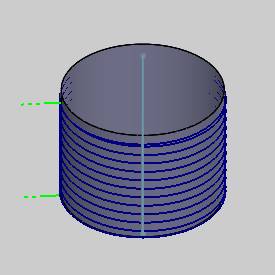
The following image shows the result with a Lead Curve that is diagonal to the cylinder.
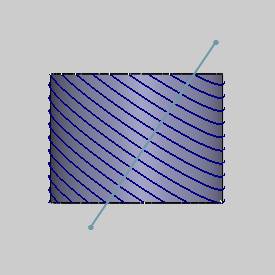
Part 7) Curve Chain Direction
The chain direction of the selected curve is used to define the start and end of the toolpath. For example, this part is currently cutting from the bottom of the part to the top.
-
To view the chain direction of the curve, in the
 CAM Tree, right-click
CAM Tree, right-click  Lead Curve and click Modify Start Point.(You may need to expand the
Lead Curve and click Modify Start Point.(You may need to expand the  Geometry folder of the Multiaxis feature.)
Geometry folder of the Multiaxis feature.) -
When you zoom-in to view the chain direction (the chain end-point is shown), you can see that it is starting at the bottom and ending at the top of the cylinder.
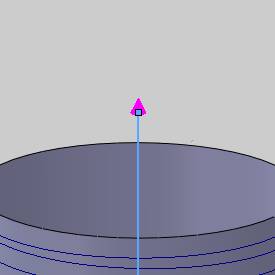
-
To change the chain direction, rotate the part, and click the curve near the start point at the bottom of the curve.
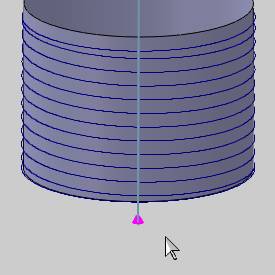
-
The chain direction of the curve is now from the top of the cylinder to the bottom.
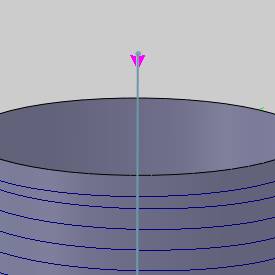
-
To confirm the new direction, click
 (OK).
(OK).
(You can also, right-click Lead Curveand click Reverse Directionto flip the chain direction.) -
To add the changes to the feature: in theCAM Tree, right click
 Feature Multiaxis, and click Compute All Toolpath.
Feature Multiaxis, and click Compute All Toolpath.
The toolpath now starts at the top of the cylinder instead of the bottom.
Part 8) Simulation
For more help using simulation, view Getting Started with Simulation.
-
To view the program, in the BobCAMmenu, click
 Simulation.
Simulation. -
During simulation, you can see that the tool is cutting on the outside of the cylinder.

-
To close simulation, in the BobCAMmenu, click
 Exit Simulation.
Exit Simulation.
Adjust the Machine Table Rotation
When you simulate the program, the machine table is sometimes rotated in a way that doesn't allow you to view the part without rotating the view of the machine. You can change the Angle Pair settings for the feature to modify the table rotation used in simulation and in the posted code.
- To edit the feature, in the CAM
Tree, right click
 Feature Multiaxis,
and click Edit.
Feature Multiaxis,
and click Edit. - Click the
Multiaxis Posting icon in the tree.
- Clear the Use
Machine Settings check box.
- In the Angle
Pair group, next to Use,
select Other Solution.
When you simulate the program again, you can now view the part being cut from the opposite side of the machine.
The table is rotated to use the other solution to the rotation angles of the primary and secondary rotary axes (angle pair). This changes the posted output of the program as well as the simulation.
Tip: You don't have to compute the toolpath to update this setting for simulation, but you must Post the program to update the code if has already been posted.
Part 9) About the Surface Normal
The surface normal of Drive Surfaces must point away from the Drive Surface in order to create the toolpath on the proper side of the surface. For this example, because the geometry used for the part is a surface and not a solid, the surface normal can be used to reverse the machining side of the part. To elaborate, if the cylindrical shell/surface is given a thickness, meaning that there is an outer surface and an inner surface, then there is a normal for each surface. In this case, the outer surface normal must point out, and the inner surface normal must point in. The machining is then applied to the selected surface.
-
To view the surface normal you must open the Selection Manager.
Under the ![]() Geometryfolder of
Geometryfolder of ![]() Feature Multiaxis, right-click
Feature Multiaxis, right-click ![]() Drive Surfaces and click Re/Select.
Drive Surfaces and click Re/Select.
The surface normal direction displays for all surfaces/faces during geometry selection for Multiaxis features.
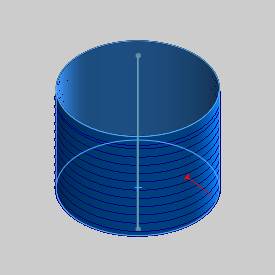
-
The next step is to reverse the surface normal to force the tool to cut the inside of the surface.
In the Selected Items box, click Face <1>, and click Reverse Normal.
The surface normal now points to the inside of the cylinder.
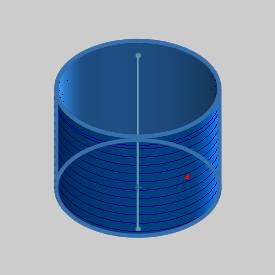
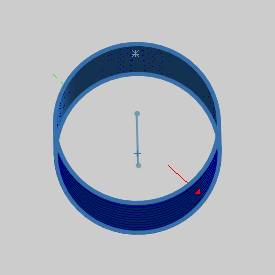
-
To finish and close the Selection Manager, click
 (OK).
(OK). -
To add the changes to the feature, right-click
 Multiaxis, and click Compute Toolpath.
Multiaxis, and click Compute Toolpath.
The toolpath is now applied to the inside of the surface.
If you were to simulate the part now, it shows that the tool is plunging directly though the part.
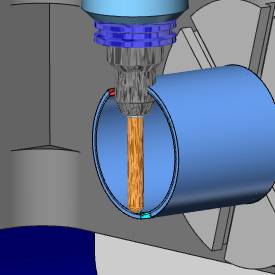
This is a result of the default tool axis orientation, which uses the surface normal to align the tool. This means that the tool orientation is at a right angle to the surface at any point(perpendicular to the tangent at the contact point.)
The tool axis orientation must be changed to correct the feature.
Part 10) Tool Axis Orientation
-
In the CAM Tree, right-click
 Feature Multiaxis,and click Edit.
Feature Multiaxis,and click Edit. -
Click Parameters, and click the Tool Axis Controltab.
-
Next to Tool Axis Will, select the tilting strategy Tilted Through Point.
-
Below Tilted Through Point, click Tilt Point.
You can type coordinate values to define the point, or for this example, click the point that is above the cylinder.
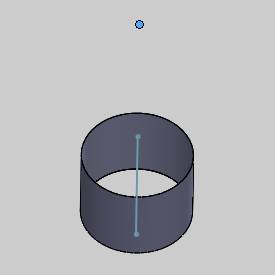
Notice that the XYZ values are updated from the selected point.
To confirm the settings and close the dialog box, click ![]() (OK).
(OK).
Part 11) Clearance Area
Now that the inside of the cylinder is being machined, the Clearance Area is changed to a plane above the part.
-
Click the Linktab, and at the bottom of the dialog box, click Retracts.
-
In the Clearance Area group, next to Type, select Plane.
In the Height box, type 5.000.
To close the dialog box, click OK. -
To add the changes to the feature, click Compute.
Notice that the toolpath moved further away from the surface (this is a result of changing the tool orientation which changed the tool contact point on the surface).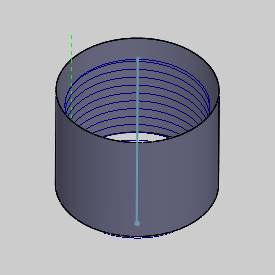
-
To view the program, in the BobCAMmenu, click
 Simulation.
Simulation.
The toolpath is now a finishing operation for the inside of the cylinder.
The tool axis orientation is always tilted through the selected point.
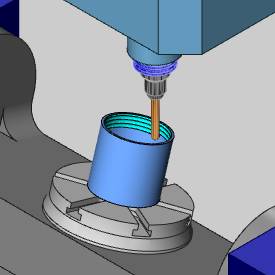
This concludes the tutorial.






